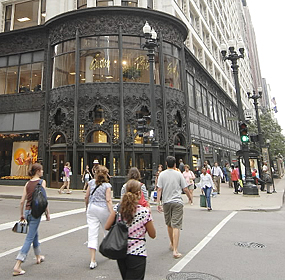What's up with department stores and Chicago's Loop?
 Carson's will be leaving its 102-year-old home by next March. The building at 1 S. State was designed by famed architect Louis H. Sullivan and is a historic landmark. (BRIAN JACKSON/SUN-TIMES)
Carson's will be leaving its 102-year-old home by next March. The building at 1 S. State was designed by famed architect Louis H. Sullivan and is a historic landmark. (BRIAN JACKSON/SUN-TIMES)Just last week, I wrote about the revitalization of Chicago's Downtown, the "Loop." This week, one of the major anchors of the State Street shopping district, the only "locally branded" department store chain left in Chicago (albeit, owned by an out-of-state company), announced on Friday that they will be closing the downtown store, that sales are down, expenses are 40% higher compared to other stores, and that the landlord offered to buy them out of their lease.
This was reported in the Chicago Tribune:
• State Street crossing threshold
• Carsons closing historic store
• Analysis: Building's future
• Editorial: Still standing;
and the Chicago Sun-Times:
• Retail icon moving out of the loop;
• Door open to new retailers, experts say.
All last year I wrote about how department stores can be a format with competitive advantage for downtowns, even as more and more shopping centers are trying to move away from being centered upon department stores, and as the industry continues to consolidate. (Also see "After Smooth Sales Talk, Stores Take Macy's Name" from today's New York Times.)
But, that turns out to be a bit of an over-broad statement.
It depends on how attractive the downtown is as a retail destination. For Chicago-sized department stores, most downtowns can't support multiple 6-10 story department stores each with over 1 million square feet of selling space, because there aren't enough people coming downtown to shop. (The average department store in a shopping mall is two to three floors, and a couple hundred thousand square feet.) Department stores in Manhattan benefit from huge numbers of visitors to "The City" as well as office workers more inclined to shop in the city than the typical cube dweller.
As downtown Chicago shifts its retail offer as more people begin living there, big department stores are less relevant--because people buy only so many shirts or sofas or suits in one year.
I still think smaller department stores can work in the context of downtown commercial district revitalization, but it really depends on the size of the retail trade area that the store can truly count on to draw customers. (The link focuses on "drive time." Center cities, especially attractive to tourists and in-region visitors, and transit rich, are analyzed with other metrics.)
Also see Understanding Your Trade Area: Implications for Retail Analysis, a publication by the Mississippi State University Dept. of Extension, Community Resource Development section.
Index Keywords: commercial-district-revitalization



0 Comments:
Post a Comment
<< Home